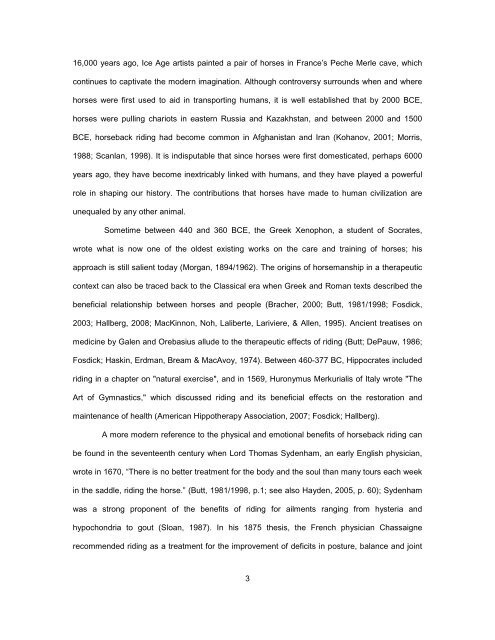A SYSTEMATIC REVIEW OF THE EFFECTS OF PSYCHOTHERAPY ...
A SYSTEMATIC REVIEW OF THE EFFECTS OF PSYCHOTHERAPY ...
A SYSTEMATIC REVIEW OF THE EFFECTS OF PSYCHOTHERAPY ...
Create successful ePaper yourself
Turn your PDF publications into a flip-book with our unique Google optimized e-Paper software.
16,000 years ago, Ice Age artists painted a pair of horses in France’s Peche Merle cave, which<br />
continues to captivate the modern imagination. Although controversy surrounds when and where<br />
horses were first used to aid in transporting humans, it is well established that by 2000 BCE,<br />
horses were pulling chariots in eastern Russia and Kazakhstan, and between 2000 and 1500<br />
BCE, horseback riding had become common in Afghanistan and Iran (Kohanov, 2001; Morris,<br />
1988; Scanlan, 1998). It is indisputable that since horses were first domesticated, perhaps 6000<br />
years ago, they have become inextricably linked with humans, and they have played a powerful<br />
role in shaping our history. The contributions that horses have made to human civilization are<br />
unequaled by any other animal.<br />
Sometime between 440 and 360 BCE, the Greek Xenophon, a student of Socrates,<br />
wrote what is now one of the oldest existing works on the care and training of horses; his<br />
approach is still salient today (Morgan, 1894/1962). The origins of horsemanship in a therapeutic<br />
context can also be traced back to the Classical era when Greek and Roman texts described the<br />
beneficial relationship between horses and people (Bracher, 2000; Butt, 1981/1998; Fosdick,<br />
2003; Hallberg, 2008; MacKinnon, Noh, Laliberte, Lariviere, & Allen, 1995). Ancient treatises on<br />
medicine by Galen and Orebasius allude to the therapeutic effects of riding (Butt; DePauw, 1986;<br />
Fosdick; Haskin, Erdman, Bream & MacAvoy, 1974). Between 460-377 BC, Hippocrates included<br />
riding in a chapter on "natural exercise", and in 1569, Huronymus Merkurialis of Italy wrote "The<br />
Art of Gymnastics," which discussed riding and its beneficial effects on the restoration and<br />
maintenance of health (American Hippotherapy Association, 2007; Fosdick; Hallberg).<br />
A more modern reference to the physical and emotional benefits of horseback riding can<br />
be found in the seventeenth century when Lord Thomas Sydenham, an early English physician,<br />
wrote in 1670, “There is no better treatment for the body and the soul than many tours each week<br />
in the saddle, riding the horse.” (Butt, 1981/1998, p.1; see also Hayden, 2005, p. 60); Sydenham<br />
was a strong proponent of the benefits of riding for ailments ranging from hysteria and<br />
hypochondria to gout (Sloan, 1987). In his 1875 thesis, the French physician Chassaigne<br />
recommended riding as a treatment for the improvement of deficits in posture, balance and joint<br />
3
















